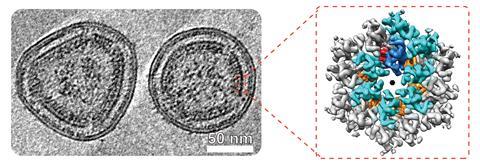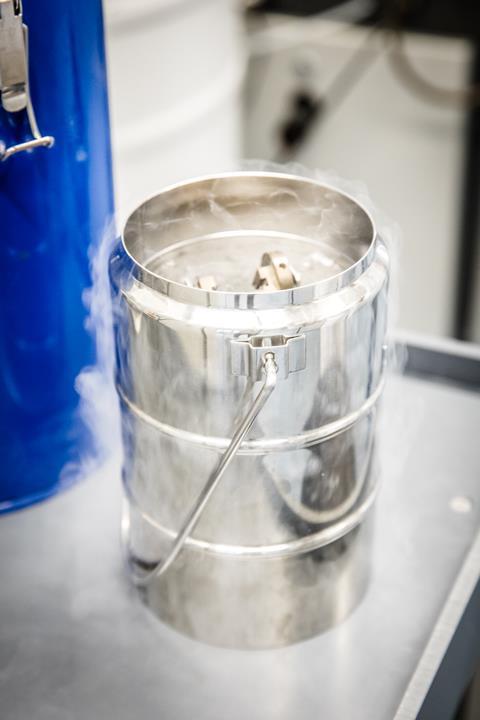Martin Obr has meticulously analyzed the “perfect sample”, one that helped him and Florian Schur from the Institute of Science and Technology Austria (ISTA) to decode the structure of a virus called HTLV-1 (Human T-cell Leukemia Virus Type 1).

In collaboration with the University of Minnesota and Cornell University, the scientists provide new details into the virus’ architecture using Cryo-Electron Tomography (Cryo-ET)—a method to analyze the structures of biomolecules in high resolution. Their results were published in Nature Structural & Molecular Biology.
READ MORE: New drug target identified for diseases associated with leukemia-causing virus
READ MORE: Gene scissors used successfully in the laboratory against HIV-related virus
Obr and Schur first crossed paths while working on HIV-1 (Human Immunodeficiency Virus Type 1), aiming to better understand its structure. Obr then joined Schur’s research group at ISTA as a postdoc. They shifted their focus to HTLV-1—a lesser-known virus from the same retrovirus family as HIV-1—due to a limited understanding of its architecture. “HTLV-1 is somewhat the overlooked cousin of HIV,” says Schur. “It has a lower prevalence than HIV-1, yet there are many cases around the world.”
Aggressive diseases
According to the World Health Organization, between 5 and 10 million people are currently living with HTLV-1. While most of the infections remain asymptomatic, roughly 5% lead to aggressive diseases like adult T-cell leukemia/lymphoma—a form of cancer with a prognosis of less than a year.
“As a human pathogen causing severe diseases, HTLV-1 should be at the forefront of our research to address the questions about its functions and structure,” adds Obr.
The scientists were particularly interested in the virus particle’s structure—information that has remained elusive until now.
Viral lattice
“When a virus gets produced, it generates a particle. This particle, however, is not yet infectious. The immature virus particle must undergo a maturation process to become infectious,” explains Schur.
The HTLV-1 particle is shaped by a lattice of proteins (building blocks) arranged into a spherical shell. This shell serves a critical function: it protects the viral genetic material until the host cell is infected. But what does this lattice look like in detail, what are its key components, and does it vary from other viruses?
“We were expecting a difference from other viruses, but the extent of it completely blew us away,” says Obr.
Unique virus
The scientists’ analysis revealed that the lattice of immature HTLV-1 is remarkably distinct from other retroviruses. Its building blocks are put together in a unique fashion, and as a result, its overall architecture looks different. Additionally, the ‘glue’ that holds the construct together also differs.
In most retroviruses, the lattice consists of a top and a bottom layer; typically, the bottom layer acts as the glue, maintaining structural integrity, while the top layer defines the shape. “In HTLV, it’s the other way around. The bottom layer is basically just hanging by a thread,” says Schur.
Naturally, the question of why HTLV-1 has such a different lattice architecture arises. A possible explanation might be that HTLV-1 has a unique way of transmission. HTLV-1 prefers to have one infected cell next to an uninfected one to spread with direct contact. HIV-1, on the other hand, uses cell-free transmission. It produces particles that can travel anywhere in the bloodstream.
“From an evolutionary standpoint, it was probably advantageous for HTLV-1 to change its lattice structure for this kind of transmission. Nevertheless, at this point, it is only speculation. It needs to be experimentally verified,” Obr continues.
New treatment strategies
Understanding these structural details is a crucial step forward, as the paper could pave the way for novel treatment approaches to combat HTLV-1 infections.
There are different ways to interfere with retrovirus infectivity. For example, one could block the mature virus at the stage of infection. Alternatively, one could target the immature virus and prevent it from maturing and becoming infectious. Since the scientists’ study details the architecture of the immature virus, one can now think of strategies for tackling the virus during this stage of its maturation.
“There are types of viral inhibitors that disrupt the assemblies by targeting the building blocks to prevent them from coming together. Others work by destabilizing the lattice,” says Schur. “There are many possibilities.”
Perfect ‘ice cold’ sample
Despite their experience analyzing viruses of the same family, such as HIV-1, the team’s current research project on HTLV-1 brought its unique challenges. Obr’s “perfect sample” was the turning point.

Due to safety reasons, the sample does not contain the actual virus. Instead, the scientists produced viral-like particles in mammalian cell cultures or generated the viral building blocks in bacterial cultures.
“When these building blocks are placed in the correct conditions, they self-assemble into structures that resemble the actual immature virus,” explains Schur. These non-infectious particles are then rapidly frozen, stored at -196 °C in liquid nitrogen, and eventually imaged using a Cryo-Electron Microscope (Cryo-EM)—a type of microscope that captures high-resolution images down to a nanometer.
But can we be sure the scientists are looking at the real thing? A valid concern, as Obr notes, “Our virus-like particles only lack a few enzymes that would help them to mature. There is no reason to think the real immature particle does look different.” This careful approach, however, ensures that researchers can study viruses safely while still gaining invaluable insights.







No comments yet